

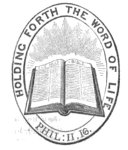 He was a keen committee man, active on various bodies formed around
this time: local treasurer of the Scripture Readers' Association
(formed in 1844 to provide support to clergy in poor areas - logo right - at which time he lived at 6 Anchor Terrace, Southwark), clerical
secretary of the Church of England Education Society (established in
1853 to promote Education in Elementary and National Schools on sound
Protestant Evangelical principles...), a committee member of the
Metropolitan Sunday Rest Association (which in 1859 appealed to 'The
Higher Classes of Society on the Duty of Discouraging Sunday Trading'),
and attended meetings of the Protestant Reformation Society ('for
promoting the religious principles of the Reformation, and for Special
Missions to Roman Catholics in Great Britain'), the Church Association,
the Church Missionary Society, the Church of England Sunday School
Institute, The Prayer Book and Homily Society and the London Society
for Promoting Christianity among the Jews.
He was a keen committee man, active on various bodies formed around
this time: local treasurer of the Scripture Readers' Association
(formed in 1844 to provide support to clergy in poor areas - logo right - at which time he lived at 6 Anchor Terrace, Southwark), clerical
secretary of the Church of England Education Society (established in
1853 to promote Education in Elementary and National Schools on sound
Protestant Evangelical principles...), a committee member of the
Metropolitan Sunday Rest Association (which in 1859 appealed to 'The
Higher Classes of Society on the Duty of Discouraging Sunday Trading'),
and attended meetings of the Protestant Reformation Society ('for
promoting the religious principles of the Reformation, and for Special
Missions to Roman Catholics in Great Britain'), the Church Association,
the Church Missionary Society, the Church of England Sunday School
Institute, The Prayer Book and Homily Society and the London Society
for Promoting Christianity among the Jews.  A note on
White's Row Episcopal Chapel: this was one of several dissenting
chapels in the area which for various reasons were taken over by the
Church of England - compare the three in our own parish: Trinity Episcopal Chapel, and a few years later St Matthew Pell Street and St Saviour & St Cross.
It had a particularly colourful history. Built around 1755 for an
Independent/Congregational congregation, many of them Huguenots, it
flourished for some years but the much-reduced congregation left in
1836 for a new chapel in Bishopsgate when the lease was due to expire.
In 1838 it was taken over by Robert Aitken, a Scots Calvinist ordained
by the Bishop of Chester but removed from his post because of his
'flirtings' with Methodism, on the Isle of Man. He had become a
flamboyant revivalist preacher with a chapel in Liverpool, and
established a similar congregation here. When his wife died in 1839 he
had something of a breakdown, and under the influence of a wealthy heiress Wilhelmina
Macdowell Grant (whom he later married) he became an ardent Tractarian
- while retaining his Methodist fervour - and made a public act of
solemn penitence and reconciliation to the Church of England (at the
'advanced' church of St Jude Liverpool); after a spell at Dr Hook's
church in Leeds Aitken became the incumbent of Pendeen, in Cornwall,
but before he left London the
Bishop of London licensed White's Row as a district chapel of the
parish church, in 1841. It was then taken over by Robert Dillon,
another popular preacher who attracted wealthy women, who in 1840 had
been suspended from his cure of a proprietory chapel in Pimlico after
an investigation into his private life triggered by corrupt dealing
over a parochial appointment. He turned the chapel into the base of his
'Reformed Church of England' in which he dressed himself in episcopal
robes and conducted an ordination. The black American evangelist Zilpha Elaw spoke here during her time in London. Dillon died (in the vestry) in 1847,
and a few years later, until the mid-1870s (prior to its demolition),
the chapel became a Catholic Apostolic Church..... A note on
White's Row Episcopal Chapel: this was one of several dissenting
chapels in the area which for various reasons were taken over by the
Church of England - compare the three in our own parish: Trinity Episcopal Chapel, and a few years later St Matthew Pell Street and St Saviour & St Cross.
It had a particularly colourful history. Built around 1755 for an
Independent/Congregational congregation, many of them Huguenots, it
flourished for some years but the much-reduced congregation left in
1836 for a new chapel in Bishopsgate when the lease was due to expire.
In 1838 it was taken over by Robert Aitken, a Scots Calvinist ordained
by the Bishop of Chester but removed from his post because of his
'flirtings' with Methodism, on the Isle of Man. He had become a
flamboyant revivalist preacher with a chapel in Liverpool, and
established a similar congregation here. When his wife died in 1839 he
had something of a breakdown, and under the influence of a wealthy heiress Wilhelmina
Macdowell Grant (whom he later married) he became an ardent Tractarian
- while retaining his Methodist fervour - and made a public act of
solemn penitence and reconciliation to the Church of England (at the
'advanced' church of St Jude Liverpool); after a spell at Dr Hook's
church in Leeds Aitken became the incumbent of Pendeen, in Cornwall,
but before he left London the
Bishop of London licensed White's Row as a district chapel of the
parish church, in 1841. It was then taken over by Robert Dillon,
another popular preacher who attracted wealthy women, who in 1840 had
been suspended from his cure of a proprietory chapel in Pimlico after
an investigation into his private life triggered by corrupt dealing
over a parochial appointment. He turned the chapel into the base of his
'Reformed Church of England' in which he dressed himself in episcopal
robes and conducted an ordination. The black American evangelist Zilpha Elaw spoke here during her time in London. Dillon died (in the vestry) in 1847,
and a few years later, until the mid-1870s (prior to its demolition),
the chapel became a Catholic Apostolic Church..... |
| 22 August 1855
My dear Sir, You were licensed under other circumstances as Senior Curate: for Mr. Paddon retains as Vicar his chief responsibility and refused in writing to me to entrust you with it. By the sequestration of the living this oversight of the Vicar is for the time removed: and I am by the Act of Parliament chargeable with the duty of providing a Senior Curate. This I am about to do. Your income will still be as now £100 and I will make myself responsible for £10 a year more in lieu of Lodging if you if you wish to remain as I hope you may under the new Curate. You ought to take into account in settling this the probability of Mr. Paddon's return next year and your continuance under him. I shall be glad at your early convenience to receive your decision as to remaining as I wish to fix the day for the new Curate's coming. I am yours ever, S. Oxon |
| 28 August 1855 My dear Mr Poyntz, I by no means wish to expose your health to risk; when therefore the weather is wet or stormy I do not require you to go into the Church. But when the weather is favourable and no such danger to your health exists then I must require you to give the parishioners the full burial service going into the Church for it until the Cemetery Chapel is built. This I hope speedily to see effected. I must beg your immediate answer whether you will retain the Second Curacy of Wycombe with the stipend of £100 (to which I will secure the addition of £10 for lodging) under the first Curate whom I am about to license loco vicarii or whether you adhere to your resignation of the Curacy. |
| 14 September 1855 My dear Sir, I was about to write to you as I promised, to say that Mr. Rice has made arrangements for taking at once possession of the Curacy of Wycombe; and as you persevere in your resolution not to continue in your Curacy under him, and I cannot consistently with what I deem the interests of the Parish place you in loco vicarii, I have desired the Registrar to cancel your licence on resignation at the same date with the licensing of Mr. Rice. In this case therefore there is no 'notice' needful: and as the bringing of the Second Curate depends upon my at once establishing Mr. Rice in the Curacy I think it best that you should resign it to him whatever day next week he is able to take possession. Though I think that your decision about burials was [deficient] in judgement I have no fault to find with your conduct as Curate of Wycombe: nor does my feeling it necessary to put another into the very responsible post which the Vicars conduct leaves open imply on my part any blame of you. I should be very happy to find you if I can another post in my Diocese. There is one now vacant at Edgcott in your own County of £90 a year to which I shall be happy at once to license you. I am ever most truly yours, S. Oxon. |
| THE REV J.J. MANLEY M.A., Etonian, Graduate in Honours Oxford 1852, assisted by a resident Graduate in Honours of Cambridge, receives SIX GENTLEMEN to prepare them for the Universities or Bishops Examinations. VACANCIES after Christmas. Address: Cottered Rectory, Buntingford, Herts. |
 Like other clergy mentioned in these pages,
he was a naturalist: he presented a bonnet-monkey (macacus radiatus) to the
Zoological Society of London in 1866. He also bred cats (see this 1896 catalogue) and dogs: Rawdon Briggs
Lee's 1897 History & Description of the Modern Dogs of Great
Britain & Ireland says that he and his neighbour, the Rev. J. Pooley, ought
... to be mentioned as owners of pointers of undoubted excellence. Details of his liver and white bitches Regent of Milton, Romp of Milton, Milton Ringlet, and dog Rex of Milton, are here for those who want details. In 1886 Punch,
under the title 'To Bee or Not To Bee', reported that he had announced
to a friend that some of his bees had recently been attempting to
extract honey from his study carpet (presumably from the flowers
figuring in its pattern), and the magazine offered some similar
anecdotes for consideration. Finally, he was a keen archer: Horace
Ford's Theory & Practice of Archery (1887) lists his scores at the Grand National Archery Meetings in Exeter in 1859 and Bath in 1860, and The Archer's Register of
1889 says that in a variety of ways
he contributed much to the prosperity of the Society and the interests of
archery in general. His daughter Amy married a colonel in India in 1908.
Like other clergy mentioned in these pages,
he was a naturalist: he presented a bonnet-monkey (macacus radiatus) to the
Zoological Society of London in 1866. He also bred cats (see this 1896 catalogue) and dogs: Rawdon Briggs
Lee's 1897 History & Description of the Modern Dogs of Great
Britain & Ireland says that he and his neighbour, the Rev. J. Pooley, ought
... to be mentioned as owners of pointers of undoubted excellence. Details of his liver and white bitches Regent of Milton, Romp of Milton, Milton Ringlet, and dog Rex of Milton, are here for those who want details. In 1886 Punch,
under the title 'To Bee or Not To Bee', reported that he had announced
to a friend that some of his bees had recently been attempting to
extract honey from his study carpet (presumably from the flowers
figuring in its pattern), and the magazine offered some similar
anecdotes for consideration. Finally, he was a keen archer: Horace
Ford's Theory & Practice of Archery (1887) lists his scores at the Grand National Archery Meetings in Exeter in 1859 and Bath in 1860, and The Archer's Register of
1889 says that in a variety of ways
he contributed much to the prosperity of the Society and the interests of
archery in general. His daughter Amy married a colonel in India in 1908. 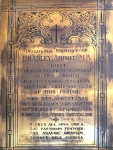 Bradley Abbott (1854-55) - from
Trinity College Dublin (despite Bishop Blomfield's reluctance to ordain
TCD men - see here),
after a year's curacy at Holy Trinity Brompton (an unlikely
breeding-ground for ritualists today!) and a year here (the registers
show he was energetic in getting parents to bring their children for
baptism), he spent the
rest of his ministry building up Christ Church, Clapham (then in the
diocese of Winchester) notorious as a centre of 'advanced' worship.
The Church and State Review
of 1864 describes with horror an elaborate funeral service for a child
in the church, with plainsong psalms and the censing of the coffin
(surrounded by a profusion of white flowers).
He worked hard at adult education, with classes several evenings a
week. A large silk and velvet processional banner of the five wounds of
Christ was made in his honour in 1873. Right is his memorial tablet at Christ Church.
Bradley Abbott (1854-55) - from
Trinity College Dublin (despite Bishop Blomfield's reluctance to ordain
TCD men - see here),
after a year's curacy at Holy Trinity Brompton (an unlikely
breeding-ground for ritualists today!) and a year here (the registers
show he was energetic in getting parents to bring their children for
baptism), he spent the
rest of his ministry building up Christ Church, Clapham (then in the
diocese of Winchester) notorious as a centre of 'advanced' worship.
The Church and State Review
of 1864 describes with horror an elaborate funeral service for a child
in the church, with plainsong psalms and the censing of the coffin
(surrounded by a profusion of white flowers).
He worked hard at adult education, with classes several evenings a
week. A large silk and velvet processional banner of the five wounds of
Christ was made in his honour in 1873. Right is his memorial tablet at Christ Church.| The name of the Rev. Bradley Abbott has been a well-known one in the annals of Church life in South London. For forty years he laboured in one sphere, and when.....he died, while on his holiday abroad, it was recognised by all parties in the locality that a good, if not a great, man had passed away. 'Father' Abbott, as he was almost universally called, was Vicar of Christ Church, Clapham, a district lying between Larkhall Lane and Wandsworth Road. He built the church, and even to-day it is more often associated with his name than called by its legal designation. 'Father' Abbott was one of the pioneers of advanced ritualism in South London. I remember attending the church nearly a quarter of a century ago, and being impressed by the ornateness of the service. 'Fancy ritual' it was called then, even by some who were in sympathy with it..... [click the link above to read the full account] |
 Robert Hebert Quick [right], a
lifelong friend of the Vicar J.L.Davies, served as an unpaid curate from
1854-58, preaching, baptizing occasionally and conducting a number
of weddings. He later became a leading educationalist - see his
biography The Life and Remains of the Rev. R.H. Quick (Macmillan 1899). More details
about his life and work here.
Robert Hebert Quick [right], a
lifelong friend of the Vicar J.L.Davies, served as an unpaid curate from
1854-58, preaching, baptizing occasionally and conducting a number
of weddings. He later became a leading educationalist - see his
biography The Life and Remains of the Rev. R.H. Quick (Macmillan 1899). More details
about his life and work here.
| His curate is one of the men, a class, one would believe, from which something is to be expected, who would combine a decent order of worship and a zealous discharge of functions, priestly, if not sacerdotal, with liberal doctrine. In Shyre he finds an appropriate field for his labours.- There is no order or beauty of ritual, no life in the parochial ministrations. How he strives for better things, what hindrances and what help he finds from those about him, all this is described in a vigorous, life-like fashion, personal experience manifestly helping the writer throughout. Pareochial politics are discussed with the disaffected or indifferent townsfolk; sanitary reform with the selfish and pig-headed proprietors of cottage property; great intellectual questions, such as the bearing of science on religious belief, with the men of cultivation whom our curate, happier so far than many whom fate drops down in the average country town, finds among his parishioners. It is inevitable that the talk on these subjects should be, sometimes at least, more ponderous than befits the style of dialogue. That few men, in our judgment, have written as Sir Arthur Helps could write it. Yet, on the whole, it is vigorous and interesting. Perhaps the least satisfactory part of the book is the episode of the young lady who falls under the sacer dotal influences of a Romanising priest. We always expect to find some congruity between the life and the fate of the personage of a story; here we cannot see it. Why does she marry without affection, and separate from her husband, unless indeed the 'curate' himself, for whom she evidently has a preference, is to be blamed for it? Mr. Anderson is to be praised for his fortitude in resisting the temptation of marrying his hero, but poor Agnes Haswall has to suffer for it. |
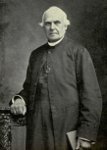
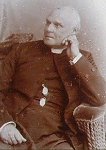 John
Cox Edg(e)hill
(1858-60) was a Theological Associate
of King's College London (made a Fellow in 1885) who began
his ministry at St Mark's; but, as one commentator put it, his health ... was not then equal to the strain, and the offer of work with the troops
... with the probability of spells abroad, was accepted as a timely
blessing. In the Army Mr Edghill may be said to have found his heart's
desire scope for plenty of work in healthy open surroundings, constant
opportunities for intercourse with fellow-men discharging responsible
duties in life, and a crying need for the reforming spirit which he
perhaps unconsciously possessed. So he went as a military chaplain to Aldershot (where, among other things, he sought to infuse heartiness into the singing at the camp services)
and then to a more senior post in Chatham; and then to Halifax, Nova
Scotia - where he was highly-regarded, and given a seat in the diocesan
synod. He returned to
Dover, then back to Aldershot, where he put his career on the line by
proposing various reforms. After a period in Gibraltar which again
tested his health and strength, he returned to a more junior post in
Aldershot, butmoved on to the garrison church at Portsmouth, where he
was highly-regarded both by the Army and the diocese of Winchester. Four
years later, he was appointed
Chaplain General to the Forces, succeeding Bishop Claughton and despite
the fact that there were sixteen other more senior chaplains. He served
in this role from 1885-1901, having meanwhile
declined the
invitation in 1887 to
become the Bishop of Halifax, Nova Scotia, on the advice of the
Archbishop of Canterbury not to leave a post for which he had been so
prepared, and for which he had been selected after long deliberation -
despite the difference in stipend (£1200 a year a bishop, as against
£500 as Chaplain-General); Frederick
Courtney was chosen in his place.
John
Cox Edg(e)hill
(1858-60) was a Theological Associate
of King's College London (made a Fellow in 1885) who began
his ministry at St Mark's; but, as one commentator put it, his health ... was not then equal to the strain, and the offer of work with the troops
... with the probability of spells abroad, was accepted as a timely
blessing. In the Army Mr Edghill may be said to have found his heart's
desire scope for plenty of work in healthy open surroundings, constant
opportunities for intercourse with fellow-men discharging responsible
duties in life, and a crying need for the reforming spirit which he
perhaps unconsciously possessed. So he went as a military chaplain to Aldershot (where, among other things, he sought to infuse heartiness into the singing at the camp services)
and then to a more senior post in Chatham; and then to Halifax, Nova
Scotia - where he was highly-regarded, and given a seat in the diocesan
synod. He returned to
Dover, then back to Aldershot, where he put his career on the line by
proposing various reforms. After a period in Gibraltar which again
tested his health and strength, he returned to a more junior post in
Aldershot, butmoved on to the garrison church at Portsmouth, where he
was highly-regarded both by the Army and the diocese of Winchester. Four
years later, he was appointed
Chaplain General to the Forces, succeeding Bishop Claughton and despite
the fact that there were sixteen other more senior chaplains. He served
in this role from 1885-1901, having meanwhile
declined the
invitation in 1887 to
become the Bishop of Halifax, Nova Scotia, on the advice of the
Archbishop of Canterbury not to leave a post for which he had been so
prepared, and for which he had been selected after long deliberation -
despite the difference in stipend (£1200 a year a bishop, as against
£500 as Chaplain-General); Frederick
Courtney was chosen in his place. | The Appellant is charged with having offended against the Laws Ecclesiastical by writing and publishing within the diocese of London certain sermons or essays, collected together in parts and volumes, the whole being designated by the title of The Sling and the Stone, in which he is alleged to have maintained and promulgated doctrines contrary and repugnant to or inconsistent with the Articles of Religion and Formularies of the Church of England. |
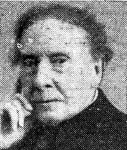
 His
appeal was dismissed and Voysey lost
his post. He returned to London and founded the Theistic Church in
1871, which welcomed former Jews alongside former Christians.
He also became an advocate of cremation.
He befriended Guy
Aldred, the
‘Boy Preacher’ of Holloway in 1903. A Corner
in the Kingdom of God: an account of some persons and things in St
Mark's, Whitechapel, 1861-63 was included in his book (a collection of six sermons) Do We Believe?
(Upfield, Green & Co., 1903): see here for a list of many of his other pamphlets. He died in
1912. His
father had been an architect, and his son Charles
Francis Annesley Voysey was a leading Arts and Crafts
designer. See the chapter on Voysey in banker and man of letters Edward Clodd's Memories (Putnam 1916), which also has a chapter on Charles Anderson (above). Left is a cartoon from Vanity
Fair 1871
– "I have much to be thankful for"; right an image from later life.
His
appeal was dismissed and Voysey lost
his post. He returned to London and founded the Theistic Church in
1871, which welcomed former Jews alongside former Christians.
He also became an advocate of cremation.
He befriended Guy
Aldred, the
‘Boy Preacher’ of Holloway in 1903. A Corner
in the Kingdom of God: an account of some persons and things in St
Mark's, Whitechapel, 1861-63 was included in his book (a collection of six sermons) Do We Believe?
(Upfield, Green & Co., 1903): see here for a list of many of his other pamphlets. He died in
1912. His
father had been an architect, and his son Charles
Francis Annesley Voysey was a leading Arts and Crafts
designer. See the chapter on Voysey in banker and man of letters Edward Clodd's Memories (Putnam 1916), which also has a chapter on Charles Anderson (above). Left is a cartoon from Vanity
Fair 1871
– "I have much to be thankful for"; right an image from later life.
 William Robert Percival (1869-71)
- described as a man of large heart,
wide sympathies, loving enthusiasm and religious earnestness: a
decade earlier, he had led a successful mission to working men in
Carlisle, publishing a pamphlet on the 'dignity of labour' question Letters to
Working Men (George Coward 1860) and a booklet Thinkings (1862), described by a reviewer in The British Controversialist as a collection
of aphorisms of considerable pith and power, always eloquent, sometimes
profound, unvaryingly religious. They are the utterances of great, but
as yet not sufficiently practised, power. Percival had
hoped that the Dean of Carlisle would support his call to
ordination (he was termed the 'Dean's curate'), but he
did not; rather, he led local clergy in opposing his preaching at the
Mechanics' Institute and YMCA. Percival's supporters therefore set up a
Congregational church and called Percival as their minister; he was
ordained by the Rev David Thomas of Stockwell Green Chapel. In 1860 the
congregation presented him with a calf-bound imperial quarto bible as a
token of their affection. As the
above
reviewer wrote, he was far more largely read in Carlyle, Emerson,
Kingsley, Maurice, Robertson (of Brighton), Arnold, &c., than
beseemed an attaché to that Closeborough
- in 1863 he also lectured on Caryle at the Carlisle Athenæum, and on Tennyson's In Memoriam
to the South End Temperance Society at the Mechanics' Institute - so it
is not surprising that, having trained for Anglican ministry at
Queen's College Birmingham, after a curacy in St Helen's from 1867-69
(see this homily 'The Spiritual Endowment of the Church', which Thomas published in his journal The Homilist in 1869) he should
serve here for a time among those who shared his views. In 1870 he lectured on Shakespeare at Wycliffe Chapel.
In 1871 he became the perpetual curate of St James' Mission, Rosemary
Branch, Islington (the parish of St James Prebend Street was
established in 1875).
Mary Smith, a feisty 'schoolmistress and nonconformist' (and
correspondent of the Carlyles) dedicated her 1892 authobigraphy to him,
as a thoughtful and catholic-minded man; a man of much wisdom.
William Robert Percival (1869-71)
- described as a man of large heart,
wide sympathies, loving enthusiasm and religious earnestness: a
decade earlier, he had led a successful mission to working men in
Carlisle, publishing a pamphlet on the 'dignity of labour' question Letters to
Working Men (George Coward 1860) and a booklet Thinkings (1862), described by a reviewer in The British Controversialist as a collection
of aphorisms of considerable pith and power, always eloquent, sometimes
profound, unvaryingly religious. They are the utterances of great, but
as yet not sufficiently practised, power. Percival had
hoped that the Dean of Carlisle would support his call to
ordination (he was termed the 'Dean's curate'), but he
did not; rather, he led local clergy in opposing his preaching at the
Mechanics' Institute and YMCA. Percival's supporters therefore set up a
Congregational church and called Percival as their minister; he was
ordained by the Rev David Thomas of Stockwell Green Chapel. In 1860 the
congregation presented him with a calf-bound imperial quarto bible as a
token of their affection. As the
above
reviewer wrote, he was far more largely read in Carlyle, Emerson,
Kingsley, Maurice, Robertson (of Brighton), Arnold, &c., than
beseemed an attaché to that Closeborough
- in 1863 he also lectured on Caryle at the Carlisle Athenæum, and on Tennyson's In Memoriam
to the South End Temperance Society at the Mechanics' Institute - so it
is not surprising that, having trained for Anglican ministry at
Queen's College Birmingham, after a curacy in St Helen's from 1867-69
(see this homily 'The Spiritual Endowment of the Church', which Thomas published in his journal The Homilist in 1869) he should
serve here for a time among those who shared his views. In 1870 he lectured on Shakespeare at Wycliffe Chapel.
In 1871 he became the perpetual curate of St James' Mission, Rosemary
Branch, Islington (the parish of St James Prebend Street was
established in 1875).
Mary Smith, a feisty 'schoolmistress and nonconformist' (and
correspondent of the Carlyles) dedicated her 1892 authobigraphy to him,
as a thoughtful and catholic-minded man; a man of much wisdom.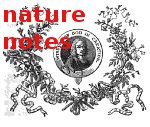 Robert
Dick Duncan (1869-77) was
born in 1822, the youngest of a Scottish professor's six sons, all
of whom were ministers in the United Secession, which split from
the Church of Scotland in 1732 and became
part of the United
Presbyterian Church
of Scotland in 1847 (see here for
more details). Before ordination he wrote nature notes for various periodicals, some of which can be seen HERE. After studying at Edinburgh University, he
was ordained to serve as the minister of Wishart Church in
Dundee in 1845, having turned down posts in Girvan (to succeed his
eldest brother) and Montrose, despite the fact that the callers were only 106 in number; they paid off
a property debt of £850 with a grant of £250 from the Board, and gained
more members when a neighbouring minister, at Bell Street, retired. He
moved to Bread Street
Church, Edinburgh in 1848, where his six children by his wife Margaret Elder were baptized. He
published a pamphlet Popery:
its
crimes, and our duty in reference to it (Oliphant, 1861), a set of
six services and sermons under the title of Sanctuary at Home, or
Lord's day services and sermons for Christian invalids, mothers,
emigrants, soldiers, sailors, or others detained from the House of God (1862), and
some years previously a pamphlet on The
Eldership (Veitch 1853), which enjoins strict compliance with the
Letter of James on their visiting the sick but dismisses anointing as but beautifully poetic
allusions. He had a high view of elders' authority: By
the appointment of the Redeemer the session is the head of the
congregation, and it is a suicidal act in any of the members of the
body to injure the head, and treasonable to the authority of the king
of the church.
Robert
Dick Duncan (1869-77) was
born in 1822, the youngest of a Scottish professor's six sons, all
of whom were ministers in the United Secession, which split from
the Church of Scotland in 1732 and became
part of the United
Presbyterian Church
of Scotland in 1847 (see here for
more details). Before ordination he wrote nature notes for various periodicals, some of which can be seen HERE. After studying at Edinburgh University, he
was ordained to serve as the minister of Wishart Church in
Dundee in 1845, having turned down posts in Girvan (to succeed his
eldest brother) and Montrose, despite the fact that the callers were only 106 in number; they paid off
a property debt of £850 with a grant of £250 from the Board, and gained
more members when a neighbouring minister, at Bell Street, retired. He
moved to Bread Street
Church, Edinburgh in 1848, where his six children by his wife Margaret Elder were baptized. He
published a pamphlet Popery:
its
crimes, and our duty in reference to it (Oliphant, 1861), a set of
six services and sermons under the title of Sanctuary at Home, or
Lord's day services and sermons for Christian invalids, mothers,
emigrants, soldiers, sailors, or others detained from the House of God (1862), and
some years previously a pamphlet on The
Eldership (Veitch 1853), which enjoins strict compliance with the
Letter of James on their visiting the sick but dismisses anointing as but beautifully poetic
allusions. He had a high view of elders' authority: By
the appointment of the Redeemer the session is the head of the
congregation, and it is a suicidal act in any of the members of the
body to injure the head, and treasonable to the authority of the king
of the church. 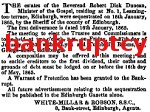 This was to redound on him, for in 1865 disturbing influences brought his labours in Edinburgh to a close. He was declared bankrupt [London Gazette 20 January, p313], with
debts of £4,000, to
the great scandal of religion and disgrace of his sacred profession, as
his elders put it, who declared that his usefulness
among them was gone. Suspended
for three months, he was restored after satisfactory professions of
penitence,
but soon moved to Barrow-in-Furness, where there were similar problems
and his resignation (a letter of declinature) from the ministry was accepted by the Lancashire
Presbytery in 1867. The Edinburgh Gazette of 27 November 1868 lists his bankruptcy, describing him as a deacon in holy orders, of Lance Lane, Wavertree near Liverpool: after further study at Edinburgh University, he had been ordained into
the Church of England (today's rules about bankrupts did
not apply then!) and became curate at St Mark's for eight years
from
1869, and served at St George-in-the-East until his death in 1883. He
took the lion's share of baptisms and weddings, alongside his Vicar and
fellow-curates - see here for statistics.
This was to redound on him, for in 1865 disturbing influences brought his labours in Edinburgh to a close. He was declared bankrupt [London Gazette 20 January, p313], with
debts of £4,000, to
the great scandal of religion and disgrace of his sacred profession, as
his elders put it, who declared that his usefulness
among them was gone. Suspended
for three months, he was restored after satisfactory professions of
penitence,
but soon moved to Barrow-in-Furness, where there were similar problems
and his resignation (a letter of declinature) from the ministry was accepted by the Lancashire
Presbytery in 1867. The Edinburgh Gazette of 27 November 1868 lists his bankruptcy, describing him as a deacon in holy orders, of Lance Lane, Wavertree near Liverpool: after further study at Edinburgh University, he had been ordained into
the Church of England (today's rules about bankrupts did
not apply then!) and became curate at St Mark's for eight years
from
1869, and served at St George-in-the-East until his death in 1883. He
took the lion's share of baptisms and weddings, alongside his Vicar and
fellow-curates - see here for statistics. 
 Daniel Reakes (1880-83)
trained for ordination at Highbury College in Islington*, he had been Lay Preacher at St Stephen
Walworth [then in Rochester
diocese] and began his ordained ministry here, then becoming
curate and afternoon lecturer
of St Mary Whitechapel (where he was a local committee member of the Charity Organisation Society
and supporter of the National Temperance League); from 1888-1900 he was
Vicar of St Paul Sheerness and acting Chaplain to the Forces: this was
an HM dockyard church built in the Bluetown district in 1873 [right], demolished in the 1960s and now part of the benefice of West Sheppey; here he supported local residents during the major 1897 floods. In 1900 he became Vicar of Wilsden, on the edge
of Bradford [then in Ripon diocese], and later of Leake, near Thirsk, where he died, probably in 1913.
Daniel Reakes (1880-83)
trained for ordination at Highbury College in Islington*, he had been Lay Preacher at St Stephen
Walworth [then in Rochester
diocese] and began his ordained ministry here, then becoming
curate and afternoon lecturer
of St Mary Whitechapel (where he was a local committee member of the Charity Organisation Society
and supporter of the National Temperance League); from 1888-1900 he was
Vicar of St Paul Sheerness and acting Chaplain to the Forces: this was
an HM dockyard church built in the Bluetown district in 1873 [right], demolished in the 1960s and now part of the benefice of West Sheppey; here he supported local residents during the major 1897 floods. In 1900 he became Vicar of Wilsden, on the edge
of Bradford [then in Ripon diocese], and later of Leake, near Thirsk, where he died, probably in 1913.  *
Confusingly, there were several institutions officially or colloquially
known as 'Highbury College', those of Anglican foundation having strong
links with the parish churches of Islington, an evangelical powerhouse.
The Independent/Congregational ministerial training college, formerly Hoxton / Homerton Academy, whose Mile End and other origins are told here, moved into a grand Ionic-style building [right] with
two wings (reminiscent of the British Museum) in Highbury Park North /
Vale (later renamed Aubert Park) in 1826, remaining there until 1850;
this eventually became New College on the Finchley Road, part of the
University of London since 1936. The premises then became the Church of England Metropolitan Training Institution (also known as Highbury College), instituted in 1849 to
train pious persons as masters and mistresses of juvenile schools
connected with the Established Church, upon principles Scriptural,
Evangelical, and Protestant, under the superintendence of the National Society. This
closed in 1864 (as did a sister institution in Chichester) because of
the impact of new educational provision by the government, the revised code making
schoolteaching less attractive (or so it was alleged), though in due
course the NS was to found a number of new colleges. In 1866 it became Highbury College of Divinity
(later St John's Hall), founded in 1863 in temporary accommodation in
St John's Wood by the Revd Alfred Peache & his sister Kezia as a
strictly evangelical theological college (against a background of
suspicion of 'seminaries', for other foundations were anglo-catholic:
see this note
on ordination training). St John's Hall had 22 students in 1866, 44 in
1870, and by 1875 had produced 142 candidates for ordination. Few
reached the degree-level standards they hoped to achieve; from 1909 St
John's Hall (later College) in Durham sought to remedy this, but in
1934 the London College of Divinity, associated with London University,
was founded. They left the site in 1939, eventually moving to
Northwood, and thence to their present home in Bramcote, Nottingham (as
St John's College). In 1913 six acres of the site had been leased to
Arsenal Football Club (originally with a restriction on Sunday
playing), who bought the freehold in 1925. The college building burnt
down in 1946, and was replaced by a block of flats. The whole site was
reveloped for housing when Arsenal moved in 2006, and is now a highly
desirable location. *
Confusingly, there were several institutions officially or colloquially
known as 'Highbury College', those of Anglican foundation having strong
links with the parish churches of Islington, an evangelical powerhouse.
The Independent/Congregational ministerial training college, formerly Hoxton / Homerton Academy, whose Mile End and other origins are told here, moved into a grand Ionic-style building [right] with
two wings (reminiscent of the British Museum) in Highbury Park North /
Vale (later renamed Aubert Park) in 1826, remaining there until 1850;
this eventually became New College on the Finchley Road, part of the
University of London since 1936. The premises then became the Church of England Metropolitan Training Institution (also known as Highbury College), instituted in 1849 to
train pious persons as masters and mistresses of juvenile schools
connected with the Established Church, upon principles Scriptural,
Evangelical, and Protestant, under the superintendence of the National Society. This
closed in 1864 (as did a sister institution in Chichester) because of
the impact of new educational provision by the government, the revised code making
schoolteaching less attractive (or so it was alleged), though in due
course the NS was to found a number of new colleges. In 1866 it became Highbury College of Divinity
(later St John's Hall), founded in 1863 in temporary accommodation in
St John's Wood by the Revd Alfred Peache & his sister Kezia as a
strictly evangelical theological college (against a background of
suspicion of 'seminaries', for other foundations were anglo-catholic:
see this note
on ordination training). St John's Hall had 22 students in 1866, 44 in
1870, and by 1875 had produced 142 candidates for ordination. Few
reached the degree-level standards they hoped to achieve; from 1909 St
John's Hall (later College) in Durham sought to remedy this, but in
1934 the London College of Divinity, associated with London University,
was founded. They left the site in 1939, eventually moving to
Northwood, and thence to their present home in Bramcote, Nottingham (as
St John's College). In 1913 six acres of the site had been leased to
Arsenal Football Club (originally with a restriction on Sunday
playing), who bought the freehold in 1925. The college building burnt
down in 1946, and was replaced by a block of flats. The whole site was
reveloped for housing when Arsenal moved in 2006, and is now a highly
desirable location.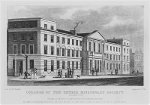 Teacher training provision was modelled on the Church Missionary Society training college (known as Highbury Missionary College),
which was the first Anglican institution for missionary training,
started in Barnsbury Park in 1820, moving two years later to a house
(for 12 students) in Upper Street and in 1825 into grand purpose-built
premises, with hall, library and lectures room for 50 students [left]; it provided some staff for the teacher training college. It
remained there until 1917 (but with students transferred to St John's
Hall, above, from 1912), actively involved in local parishes. In 1849
CMS also founded a home for the children of overseas missionaries in
Milner Square, which moved four years later to purpose-built premises
at the corner of Highbury New Park and Highbury Grove. Teacher training provision was modelled on the Church Missionary Society training college (known as Highbury Missionary College),
which was the first Anglican institution for missionary training,
started in Barnsbury Park in 1820, moving two years later to a house
(for 12 students) in Upper Street and in 1825 into grand purpose-built
premises, with hall, library and lectures room for 50 students [left]; it provided some staff for the teacher training college. It
remained there until 1917 (but with students transferred to St John's
Hall, above, from 1912), actively involved in local parishes. In 1849
CMS also founded a home for the children of overseas missionaries in
Milner Square, which moved four years later to purpose-built premises
at the corner of Highbury New Park and Highbury Grove. |
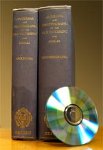
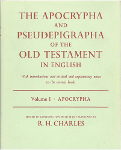
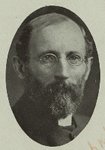 Robert
Henry Charles
(1883-85) was born at Cookstown, Co. Tyrone in 1855, he studied with
great distinction at Queen's University Belfast and Trinity College
Dublin. He served his title at St Marks, officiating regularly
on Sundays and at baptisms (some of them marked 'private') and
weddings, and two further curacies at St Philip Kensington and St Mark
Kennington (where he published Forgiveness and Other Sermons in 1887). But he left parochial ministry in 1889 and returned to academic life, becoming a professor in Dublin and Oxford
and a leading Ethiopic scholar and expert on
Jewish eschatology, the Apocrypha, Pseudepigrapha and Septuagint; many of his
translations are still in use
[reprint right, and CD with 1913 originals]. They include The Book of Enoch (Ethiopic text, 1903); Ethiopic Version of the Hebrew Book of Jubilees (1894), The Apocalypse of Baruch (Syriac text and translation, 1896); The Assumption of Moses (Latin text and translation; 1897); Critical History of the Doctrine of a Future Life in Israel, in Judaism, in Christianity (the Jowett lectures for 1898-99); The Ascension of Isaiah (Ethiopic, Greek, and Latin teats and translation,1900); The Book of Jubilees: or, The Little Genesis (translation 1902); The Ethiopic Version of the Book of Epoch (1905); Greek
Version of the Testaments of the Twelve Patriarchs with the Variants of
the Armenian and Slavonic Versions and the Hebrew and Aramaic Fragments (1906); Testament of the Twelve Patriarchs (1908); and, with W. R. Morfill, translation of the Slavonic text of The Book of the Secrets of Enoch (1898). He became a Canon of Westminster Abbey in 1913 and archdeacon
in 1919, and died in 1931.
Robert
Henry Charles
(1883-85) was born at Cookstown, Co. Tyrone in 1855, he studied with
great distinction at Queen's University Belfast and Trinity College
Dublin. He served his title at St Marks, officiating regularly
on Sundays and at baptisms (some of them marked 'private') and
weddings, and two further curacies at St Philip Kensington and St Mark
Kennington (where he published Forgiveness and Other Sermons in 1887). But he left parochial ministry in 1889 and returned to academic life, becoming a professor in Dublin and Oxford
and a leading Ethiopic scholar and expert on
Jewish eschatology, the Apocrypha, Pseudepigrapha and Septuagint; many of his
translations are still in use
[reprint right, and CD with 1913 originals]. They include The Book of Enoch (Ethiopic text, 1903); Ethiopic Version of the Hebrew Book of Jubilees (1894), The Apocalypse of Baruch (Syriac text and translation, 1896); The Assumption of Moses (Latin text and translation; 1897); Critical History of the Doctrine of a Future Life in Israel, in Judaism, in Christianity (the Jowett lectures for 1898-99); The Ascension of Isaiah (Ethiopic, Greek, and Latin teats and translation,1900); The Book of Jubilees: or, The Little Genesis (translation 1902); The Ethiopic Version of the Book of Epoch (1905); Greek
Version of the Testaments of the Twelve Patriarchs with the Variants of
the Armenian and Slavonic Versions and the Hebrew and Aramaic Fragments (1906); Testament of the Twelve Patriarchs (1908); and, with W. R. Morfill, translation of the Slavonic text of The Book of the Secrets of Enoch (1898). He became a Canon of Westminster Abbey in 1913 and archdeacon
in 1919, and died in 1931.
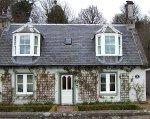 Henry Sidney Brown (1891-99)
- born in London in 1852 (baptized at St Botolph Bishopsgate), of St John's College, Oxford; ordained in 1876 by the Bishop of
Winchester (when south London still fell within that diocese), he
served four brief curacies - Camberwell, St Silas South
Lambeth
(a mission church of St Barnabas Kennington), St Saviour Brixton, All
Saints Hatcham - before crossing the river for three more - Holy Trinity Hoxton,
St Peter Clerkenwell and St Thomas Stepney. During his time here, when he lodged at 4 Wellclose
Square, he was assiduous, conducting large numbers of baptisms
and weddings. Two further south London curacies followed, at Christ
Church Croydon and
St Crispin Bermondsey, with two years as curate of Culross, Fife,
living at Burnside Cottage [right], before he returned in 1908 to a further curacy at St Matthew Fulham.
In the 1911 census he was Vicar of Bledlow Ridge, near Wallingford,
living with his sister Mary, where he died in 1916, leaving an
estate of £2425.
Henry Sidney Brown (1891-99)
- born in London in 1852 (baptized at St Botolph Bishopsgate), of St John's College, Oxford; ordained in 1876 by the Bishop of
Winchester (when south London still fell within that diocese), he
served four brief curacies - Camberwell, St Silas South
Lambeth
(a mission church of St Barnabas Kennington), St Saviour Brixton, All
Saints Hatcham - before crossing the river for three more - Holy Trinity Hoxton,
St Peter Clerkenwell and St Thomas Stepney. During his time here, when he lodged at 4 Wellclose
Square, he was assiduous, conducting large numbers of baptisms
and weddings. Two further south London curacies followed, at Christ
Church Croydon and
St Crispin Bermondsey, with two years as curate of Culross, Fife,
living at Burnside Cottage [right], before he returned in 1908 to a further curacy at St Matthew Fulham.
In the 1911 census he was Vicar of Bledlow Ridge, near Wallingford,
living with his sister Mary, where he died in 1916, leaving an
estate of £2425. | A SCENE IN A CHURCH Recently Mr. John Wilson, a Cheshire gentleman, tore down certain inscriptions placed in Astbury Church appealing to the congregation to pray for the repose of the souls of the dead. Mr. Wilson has written to the Bishop of Chester, complaining that on the following Sunday while leaving church the Rev. John Colyer, the rector's son, exclaimed in a loud voice, "You are watched, you scoundrel!" Mr. Wilson replied, "Very likely, and I am come to see if any more Popish trash is put up in this porch. It it were I should take it down." Mr Colyer said, "You dare not, you scoundrel"; to which Mr Wilson answered, "And you dare not put it up again, you Popish idiot." Mr. William Colyer. another brother, then exclaimed, "If I had caught you at it, you scoundrel, I would have half-murdered you." Mr. Wilson made an angry retort, and some members of the congregation then interfered. |
Back to St Mark Whitechapel | Back to History